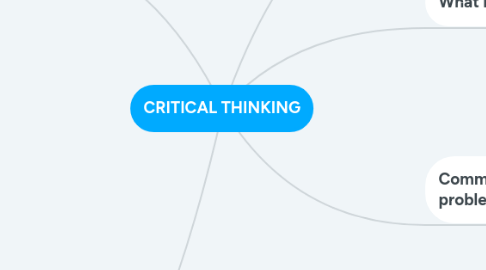
1. Critical thinking skills
1.1. Observation
1.1.1. Observational skills are the starting point for critical thinking. Employees who are observant can quickly sense and identify a new problem.
1.2. Inference
1.2.1. Inference is a skill that involves drawing conclusions about the information you collect and may require you to possess technical or industry-specific knowledge or experience.
1.3. Analysis
1.3.1. Once a problem has been identified, analysis skills become essential. The ability to analyze the situation includes knowing what facts, data or information about the problem are important.
1.4. Communication
1.4.1. Communication skills are important when it comes time to explain and discuss issues and their possible solutions with colleagues and other stakeholders.
1.5. Problem solving
1.5.1. After you’ve identified a problem, analyzed it and discussed possible solutions, the final step is to execute the solution.
2. Critical thinking exercise in classroom examples
2.1. Ask questions
2.1.1. Asking questions, especially open-ended questions, gives elementary school students a chance to apply what they’ve learned and build on prior knowledge.
2.2. Connect different ideas
2.2.1. Connecting different ideas is key to teaching critical thinking. For example, elementary school teachers can ask students if they know anyone who has to take a bus to work, and if so, why it would be important for that person to also have a train schedule.
2.3. Encourage decision-making
2.3.1. Since a large part of teaching critical thinking skills revolves around applying knowledge and evaluating solutions, elementary school teachers should encourage decision-making as much as possible.
2.4. Inspire creativity
2.4.1. Imagination is key to teaching critical thinking in elementary school. Teachers should seek out new ways for students to use information to create something new.
2.5. Work in groups
2.5.1. Group projects and discussions are another excellent way for elementary school teachers to encourage critical thinking skills.
2.6. Brainstorm
2.6.1. Brainstorming, a time-honored tradition in elementary education, is an excellent learning tool.
3. What is it?
3.1. Critical thinking is the ability to objectively analyze information to make reasonable decisions.
4. Common steps to solving problem with critical thinking
4.1. Identify ways to improve the solution
4.2. Organize and sort data and findings
4.3. Create inferences on why the problem exists and how it can be solved
4.4. Identify a problem or issue
4.5. Collect information or data on the issue through research
5. Why are critical thinking skills important?
5.1. Critical thinking skills are important because they help businesses run smoothly by solving problems, developing solutions and creating new ideas. Many areas of improvement like process inefficiencies, management or finances can be improved by using critical thought.
5.1.1. Example
5.1.1.1. if you’re working in human resources and must resolve a conflict between two employees, you will use critical thinking to understand the nature of the conflict and what action should be taken to resolve it.
